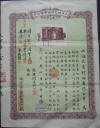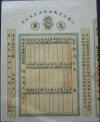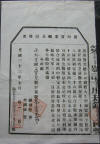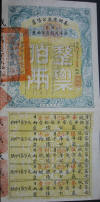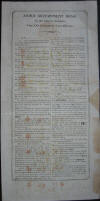Bonds and Shares
According to Wilhelm Kuhlmann's "China's Foreign Debt 1865-1982", China's first foreign debt based on security was issued in 1866, i.e., the 5th year of Tong Ze reign. As to China's domestic bond certificate, it was even late until 1898, i.e., the 24th year of Kuang Hsu reign. No clear information showing when the first stock certificate of a company was issued, according to a few specimens we found, it should be around the early of Kuang Hsu period (1875-1908). Many of the bonds and stock certificates then issued were denoted in silver taels, the rest were in silver dollars.
Shanghai Da You Oil Milling Co., Ltd. Share certificate dated the 1st day, the 4th month, Huan Tung the 3rd year (1911). Left: The share certificate; Right: Interest Sheet
The company was founded under the approval of the Ministry of Agriculture, Industry and Commerce with an authorized capital of 10,000 taels of silver in Shanghai Regulatory Scale. This is a certificate of 5 shares issued to shareholder Jin Hong Firm, each share at the price of 100 taels.
Collection of the webmaster
Tung Hai Enterprising Co., ( An official-private joint venture textile company) Share Certificate Share certificate dated the 1st day, the 7th month, Kuang Hsu 33rd year (1907).
A certificate of 426 shares issued to its shareholder Ju Chien Firm who paid in a share price of 2,130 taels of silver in Shanghai regulatory scale.
Collection of the webmaster
Hai Gan Stocks and Cultivation Co. (An official supervised, private operated company) Share Certificate, dated the 10th day, the 5th month of Kuang Hsu 32nd year (1906).
The company had an authorized capital of 300,000 taels of silver in Shanghai Regulatory Scale. This is a certificate of 10 share at the price of 1,000 taels.
Collection of the webmaster
Shanghai Commercial Association Construction Bond issued at the 15th day, the 7th month, the 13th year of the Republic of China (1924) for an aggregate loan of 60,000 taels of silver in Shanghai Regulatory Scale, 600 bonds at par value of 100 taels were issued, bearing an annual interest rated 9%. Repaid by the rental incomes of the association and secured under the guaranty of chairman and directors of the board. The bond was to be redeemed in 1935 according to the articles of issuance, but this piece, if based on its payment records, was subject to an early redemption in 1932.
Collection of the webmaster

 No.
S&B/5
No.
S&B/5
Stock Certificate of Dien-Su Tern Yue Railway Co., for one share at the par value of 5 taels of fine silver in the Ku (Treasury) scale. Dated Hsuan Tung Year Month (1909-1911) (Unissued). Left- The certificate (Left) and the receipt (Right)
Printed by Tokyo Toppan Printing Co. The watermarks "滇蜀騰越鐵路股票" (Share Certificate of Dien-Su Tern Yue Railway Company) are shown under back light.
Abstract of the ordinances for the subscription:
Authorized capital: 20,000,000 taels of silver in 4,000,000 shares.
Subscribed by Chinese nationals only; not transferable to foreigners.
Subscription price paid by silver coins, shall be exchanged for silver taels.
Annual interest rated 6%, payable to stockholders at each year-end.
Representative offices allocated in the major cities of Yunnan and other provinces for subscription of shares and payment of interests.
Under the approval by the imperial government, the company may issue paper currency as a financial aid to the annual interest payable. Said paper currency may be used as payment to the Yunnan government for all taxes.
The first 6,000,000 shares for subscription are the preferred shares, and the rest, the common shares.
Backgrounds:
In the
24th year of Kuang Hsu (1898), China suffered a blow to its sovereignty when it
was forced to grant France the right to construct and operate the Dien-Yue (Yunnan-Vietnam)
Railway connecting northern Vietnam--a French protectorate subsequent to the
Sino-French War in 1885--all the way to Kunmin, the capital of Yunnan, in China.
Only a year later the British government asked for the right to construct
another Railway connecting Kunmin and its colonial possession Burma. This time,
the Chinese imperial government and its people strongly objected. During the
negotiations with the British representatives, the Chinese envoys insisted that
each side should be responsible for construction of that portion of the railroad
within its own jurisdiction, and eventually, the British did not get the rights
they had sought.
Gradually, the Chinese imperial government became increasingly aware of the importance of a rail system, and realized that if China didn't take any action, western countries would exploit this opportunity and seize the development initiative.
With the approval and support of
the the imperial government and the public, the Dien-Su Tern Yue Railway Company
(Yunnan-Szechuan Tern Yue Company, Tern Yue was the destination at the Yunnan
end of the railroad in plan) was founded in Yunnan. This semi-official Chinese
company planned to construct a railroad connecting Yunnan and Szechuan, and then
extend it across the Yunnan Tern Yue border, to Burma. Before this plan could be
carried out, and while the company was still raising capital from the public,
the Ching government ended in the 1912 revolution, and the company ceased its
operation. Later on, the proceeds from the subscriptions were used for the
construction of a local Yunnan railroad by the new local government.
Collection of the webmaster
Anhuei Government Bond by Imperial Sanction 100 Taels of Sufficiently Pure Silver in the Treasury Scale(奏辦安徽公債票庫平足銀壹百兩) of the 2nd Year of Hsuan Tung (1910), floated by Yu Wuan Official Monetary Bureau (裕皖官錢局) and consigned by the board of revenue of the province. The total floated amount of this bond was 1,200,000 taels of Sufficiently Pure Silver in the Treasury Scale. Most of the government bonds issued during the Ching Dynasty were of foreign debt, this piece is one of the few domestic loan issued in China.
Collection of the webmaster
Shaansi 6% (Annual Interest), 5 Tael Bond Issued in the 6th Year of the Republic of China (1917 A.D.)(中華民國六年陜西陸釐地方公債) consisting of 5 identical and dividable talons titled "One Fifth of a Five Tael Bond".(伍兩公債票五分之一), and each one is attached with coupons for interests. Issuance of this bond was under the dictation of Tuchun (督軍) and Governor of the province-Liu Shu Fang (劉樹藩), a warlord dominated the province since 1916.
No information about the total amount of the bond issued can be found, but we found some others in the articles of issuance which is intriguing. According to the articles, interest for this bond will be raised from deduction of salaries of the military, politicians, scholars and lawyers, and redemption of the principal will be funded by adding taxes to the commerce. Also as indicated in the articles, the interest is payable to bondholders annually from 1919 to 1930, and the principal is to be redeemed in 1930.
Collection of the webmaster
Shanghai Municipal Council (British Administered) 1,000 Tael 7% Loan of 1922 (上海工部局1922年壹千兩七釐公債)
As stated on the certificate:
Issue of Debentures being a portion of a total authorized issue of securing principal sums not exceeding Tls. 8,000,000 or the equivalent thereof under authority of Resolution V. passed at the Annual Meeting of Ratepayers on April 19, 1922.
THE SHANGHAI MUNICIPAL COUNCIL (hereinafter called "THE COUNCIL") will on Decenber 31, 1952, or on such earlier day as the principal moneys hereby secured shall become payable in accordance with the conditions printed below, pay to Albert William, Bushill Esquise or other registered holder for the time being hereof the sum of TAELS ONE THOUSAND SHANGHAI SILVER SYCEE.
And the Council will in the meantime pay to such registered holder interest thereon at the rate of seven per cent. per annum by equal half yearly payments of JUne 30 and December 31 in each year.
The property of the Municipality and the yearly Municipal revenue are the security for these payments.......................................
Almost all these bonds based on silver tael were redeemed earlier in 1933 than stipulated, because in 1933 sycee became outlawed and was mandated to be replaced by silver dollar.
Collection of the webmaster
Return to Papers
